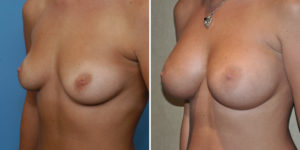One of the historic debates in primary (first time) breast augmentation is whether the implants should be placed above or below the pectoralis muscle. While this issue has various opinions amongst different plastic surgeons and has waxed and waned over the years as implant options have changed, it is important that prospective patients know the pros and cons of both approaches.
Subpectoral (under the muscle) placement of breast implants is probably done by the majority of plastic surgeons while subglandular (above the muscle) is done more selectively. Although there are a few plastic surgeons that feel that subglandular implant placement is better. Opinions and preferences aside, the relevant questions between these implant locations are how do they look and feel, are the risk of complications different and do they interfere with breast cancer detection.

While all breast implants provide some interference with mammogram readings, staying largely out of the breast tissue reduces this interference. When the implant is subpectoral, it is separated by the muscle tissue and there is a clear demarcation between the two. This is not so when the implant is placed directly into the breast tissue.
There are definitely differences in the way implants may look between the subpectoral and subglandular positions, particularly in saline-filled devices. While many breast implants may have some minor rippling along their lower edges, this is magnified when the implant is above the muscle. The pressure of the overlying muscle in subpectoral implants pushes its contents outward, stretching out the shell of the implant and reducing much of any rippling. In addition, the muscle usually covers the upper two-thirds of the implant so any shell irregularities are camouflaged.
When implants are above the muscle, its edges can be more clearly seen particularly in the upper pole. There is not a smooth transition in the upper breast between the chest wall and the implant creating an obvious transition area or edge. This look is often why some breast augmentation patients can be identified as ‘having implants’. Conversely, subpectoral implants allow for a more natural transition and breast appearance as the muscle is pushed outward and makes up a significant portion of the upper breast pole.
The recovery is quicker and easier from subglandular implants as the muscle is not disturbed. The pain is minimal and one can usually return to work in a day or two. Conversely, submuscular placement will cause greater discomfort after surgery and this may temporarily be an issue for more athletic patients or for those desiring to return to work in the first week after surgery.
Other than less recovery, there are no real advantages to have one’s breast implants placed above the muscle. There are some real disadvantages such as visible implant rippling, risk of a more unnatural appearance (with saline implants), higher potential for long-term capsular contracture, and potential interference with mammogram evaluations. Tissue plane location has no bearing on how long breast implants will last, regardless of whether they are saline or silicone-filled.
Dr. Barry Eppley
Indianapolis, Indiana


